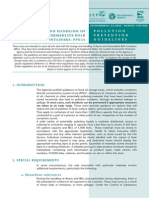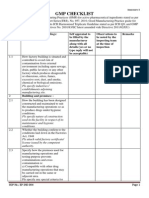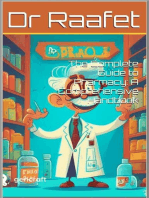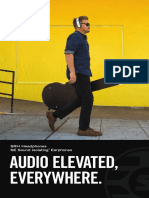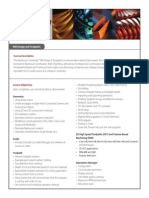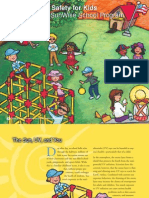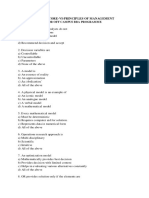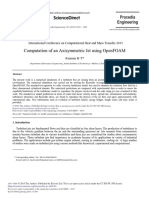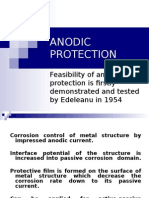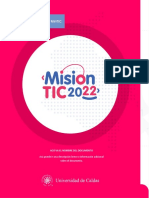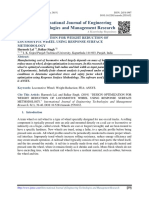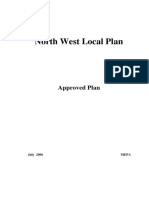Ccrule Brochure
Ccrule Brochure
Uploaded by
Cristian Jhair PerezCopyright:
Available Formats
Ccrule Brochure
Ccrule Brochure
Uploaded by
Cristian Jhair PerezOriginal Description:
Copyright
Available Formats
Share this document
Did you find this document useful?
Is this content inappropriate?
Copyright:
Available Formats
Ccrule Brochure
Ccrule Brochure
Uploaded by
Cristian Jhair PerezCopyright:
Available Formats
o
o
o
has the required markings and openings
Clean the container unless the tamper evident device
and/or one-way valve are intact and the container is
being refilled with the same product (or the new
product meets other very limited circumstances)
Repackage into a container identified in the
registrants description of acceptable containers
Ensure that the product is properly labeled and
includes his EPA establishment number and the net
contents
Keep records on the product, date and container for
each refill
3. Key Labeling Requirements ** Comply by
August 16, 2011 **
Who must comply
Registrants must incorporate the new language onto
their labels for pesticides that are released for shipment
after August 16, 2010
Pesticide users must follow the new container
management instructions as soon as they are on the
labels
New Label Statements
Labels (or containers) of nonrefillable containers will have:
o Nonrefillable container statement
o A do not reuse statement
o Recycling or reconditioning instructions
o A lot number identifying the batch
o More detailed rinsing instructions for dilutable
products in rigid containers, except for household
products
Labels (or containers) of refillable containers will have:
o A refillable container statement, and
o Instructions for cleaning the container before it is
recycled or disposed of (not before it is refilled)
4. Key Nonrefillable Container Requirements
** Comply by August 16, 2009 **
Who must comply
EPA-735L09001
December 2009
Registrants are responsible for ensuring that their nonrefillable
containers meet the standards
Nonrefillable Containers
For products that are in Toxicity Categories III and IV
(and that are not restricted use products), the containers
must meet only the basic DOT requirements in 49 CFR
173.24.
All other products (restricted use products and those in
Toxicity Categories I or II) are subject to the nonrefillable
container requirements. Consult the regulations to
determine which of the requirements your specific product
and container must comply with. Nonrefillable containers
must:
o Meet certain DOT design, construction, and marking
requirements
o Have standard closures
o Allow the contents to pour in a continuous stream (no
glugging) and with a minimum amount of dripping
down the outside of the container
o Meet a cleanability standard, and
o Keep records showing compliance
For More Information
Although the regulations (including the amendments) are final,
EPA will be posting updated guidance and additional useful
information to the PCC web site.
For the complete rule, or for additional information go to:
www.epa.gov/pesticides/regulating/containers.htm
A snapshot of the
EPA Pesticide
Container and
Containment Rule
For Registrants, Retailers, Distributors,
Commercial Applicators, Custom
Blenders, and Pesticide Users
Purpose of the Rule
EPA published a final rule called the Pesticide Container and
Containment (PCC) rule in August 2006 and made minor
amendments to the rule in October 2008. The rule seeks to:
Minimize human exposure to pesticides while handling
containers
Facilitate disposal & recycling of pesticide containers
Protect the environment from pesticide releases at bulk
storage sites and from spills & leaks when
refilling/dispensing pesticides
Who Must Comply
Each of the five parts of the rule applies to different kinds of
businesses. The PCC rule may affect you if you are a pesticide:
Registrant
Retailer
Distributor
Commercial applicator
Custom blender
User
The points below are key elements but do not cover
every aspect and detail of the PCC rule. Refer to the
final regulations for full details.
1. Key Containment Requirements ** Comply by
August 16, 2009 **
Secondary Containment Units
Tanks with capacities of 500 gallons (liquids) or 4,000
pounds (dry) or greater and that are stationary (fixed or in
place 30 days) must be in secondary containment
Tanks for liquids must be anchored or elevated to prevent
flotation
Must have a capacity of 100% if protected from
precipitation or if it existed before November 2006 OR a
capacity of 110% if not protected from precipitation and
built after November 2006
Containment Pads
Containment pads are required for:
o Emptying, cleaning or rinsing refillable containers
o Dispensing pesticides from a stationary container with
a capacity of 500 gallons or 4,000 pounds or greater
o Dispensing pesticides from a transport vehicle to fill a
refillable container
o Dispensing pesticides from any other container to fill a
refillable container for sale or distribution
Pads must have a capacity of at least 750 gallons or 100%
of the volume of the largest container (including transport
vehicles) used on the pad, whichever is less
Both Secondary Containment & Pads
Must be liquid-tight and constructed of impervious, rigid
materials compatible with agricultural pesticides stored
Must have sufficient freeboard to contain precipitation &
prevent liquids from entering
Must be inspected monthly and repaired when necessary
Facilities must keep records on maintenance & monthly
inspections
Who must comply
You may only have to comply with state pesticide containment
regulations (and not the federal regulations) if your state had
regulations in place by August 2006. Consult your state or
tribal pesticide agency or the container-containment web site
under For More Information to determine whether your
facility is subject to state, tribal or federal containment
regulations.
If you are subject to the federal pesticide containment
requirements, you must comply if you handle agricultural
pesticides and you are a:
Retailer who repackages
Commercial applicator
Custom blender
2. Key Refillable Container and Repackaging
Requirements ** Comply by August 16, 2011 **
Who must comply
If you are an independent refiller (repackage a pesticide
and are not the registrant), you must comply with the
requirements for stationary tanks and repackaging. Also,
you are indirectly subject to the requirements for portable
refillable containers
If you are a pesticide registrant, you must comply with the
requirements for stationary tanks, portable refillable
containers and repackaging
Stationary Tanks
The following requirements apply to tanks with capacities of
500 gallons (liquids) or 4,000 pounds (dry) or greater and that
are stationary (fixed or in place 30 days) and that are at the
facilities of independent refillers (who repackage a pesticide
and are not the registrant). These tanks must:
Be marked with a serial number or other identifying code
Have sufficient strength and durability
Have vents that limit evaporation
Have a lockable inlet/outlet valve
Not have external sight gauges
Be in secondary containment (if it holds an agricultural
pesticide)
Be anchored or elevated to prevent flotation (if it holds an
agricultural pesticide)
Portable Refillable Containers
Registrants are responsible for ensuring that portable refillable
containers (minibulks, totes, shuttles, IBCs, etc.):
Meet certain DOT design, construction, & marking
requirements
Are marked with a serial number or other identifying code
Have a one-way valve or tamper-evidence or both on all
openings (other than the vent)
Repackaging
Any refiller (a retailer, distributor or registrant) and registrants
are subject to the repackaging requirements, which include:
Must have a written contract between the registrant and
an independent refiller
Both the registrant and refiller are responsible for product
integrity
There are no regulatory limits on the size of refillable
containers (Registrants might establish size limits in their
contracts)
Registrants must develop and provide refillers with: (1) a
procedure to clean refillable containers, and (2) a
description of acceptable containers that meet the
requirements for stationary tanks and portable refillable
containers. (Refillers must have these documents on file)
When repackaging, a refiller must:
o Identify the previous pesticide
o Visually inspect to see if container is safe to use and
(continued on back)
You might also like
- SOP Manual Rev 24 2 - FlattenedDocument186 pagesSOP Manual Rev 24 2 - Flattenedsinusake90% (10)
- Basic GMP Checklist For Pharmaceutical PlantsDocument30 pagesBasic GMP Checklist For Pharmaceutical PlantsPrem Goel100% (10)
- Greenbrier River TrailDocument7 pagesGreenbrier River TrailCristian Jhair PerezNo ratings yet
- Shipping SopDocument8 pagesShipping SopV R Logistics LimitedNo ratings yet
- Asme B31e (2008) PDFDocument18 pagesAsme B31e (2008) PDFCristian Jhair Perez100% (3)
- Environmental Compliance ReviewDocument34 pagesEnvironmental Compliance ReviewNafi Hasan ZahidNo ratings yet
- Proposed Pesticide Container and Containment Regulations at A GlanceDocument14 pagesProposed Pesticide Container and Containment Regulations at A GlanceShiv KumarNo ratings yet
- Pet Container RequirementsDocument11 pagesPet Container RequirementsAkmaruddin Bin JofriNo ratings yet
- 3900B1 06 Sterile Drug ProductsDocument2 pages3900B1 06 Sterile Drug ProductsNaveenbabu SoundararajanNo ratings yet
- Chemical Purchasing and ProcurementDocument2 pagesChemical Purchasing and ProcurementsrinivaskirankumarNo ratings yet
- SOP Waste Management July 2016Document3 pagesSOP Waste Management July 2016vibinNo ratings yet
- Storage and Handling of Drums & Intermediate Bulk Containers:Ppg26Document6 pagesStorage and Handling of Drums & Intermediate Bulk Containers:Ppg26TC Cüneyt ŞanNo ratings yet
- Lab Self Inspection ChecklistDocument11 pagesLab Self Inspection Checklistarif_fatur324872100% (1)
- Packaging and Labelling RequirementsDocument6 pagesPackaging and Labelling RequirementsSneh MattaNo ratings yet
- Chemical Storage ProcedureDocument6 pagesChemical Storage ProcedurerajkumarveluNo ratings yet
- FSSAI and LMA NotesDocument6 pagesFSSAI and LMA NotesRAJ SINGHNo ratings yet
- Labconco-9918500 Rev F Protector Storage Cabinets - Standard-Acid-solvent and Vacuum PumpDocument40 pagesLabconco-9918500 Rev F Protector Storage Cabinets - Standard-Acid-solvent and Vacuum PumpCalixto GrajalesNo ratings yet
- Chilled WaterDocument10 pagesChilled WaterandesisNo ratings yet
- Standards For Food Quality Shipping ContainersDocument85 pagesStandards For Food Quality Shipping ContainersUmesh Hb100% (1)
- WNSFEILD Pharmaceuticals Title: Standard Operating Procedure For WFI PlantDocument30 pagesWNSFEILD Pharmaceuticals Title: Standard Operating Procedure For WFI Plantdaizhussain004No ratings yet
- Hydaranautics MembraneDocument3 pagesHydaranautics Membraneafraz_xecNo ratings yet
- Packaging and StorageDocument3 pagesPackaging and StorageIvana HalingkarNo ratings yet
- Specifications of Disposable NapkinDocument3 pagesSpecifications of Disposable Napkinbobbiliravi18No ratings yet
- Advanced Extraction Technology From UK Licensed To RC CostelloDocument5 pagesAdvanced Extraction Technology From UK Licensed To RC CostelloHunterlan Register FilanNo ratings yet
- Chapter-1 Overview APIDocument16 pagesChapter-1 Overview APIManoj LingeNo ratings yet
- General Requirements:: Quality Requirements For Wooden Pallet SpecificationsDocument8 pagesGeneral Requirements:: Quality Requirements For Wooden Pallet Specificationsirtaza324197100% (1)
- Chemical Health Safety ProgramDocument8 pagesChemical Health Safety ProgramGerard M. EncarnacionNo ratings yet
- Legal ComplaincesDocument37 pagesLegal ComplaincesUjjwal AnandNo ratings yet
- Declaration Compliance ANIA CLIFE 2011 enDocument4 pagesDeclaration Compliance ANIA CLIFE 2011 enDevaraj SubrmanayamNo ratings yet
- Checklist Oficina Auto - ENDocument2 pagesChecklist Oficina Auto - ENlinteringNo ratings yet
- GUIDE-MQA-017-006 (Good Manufacturing Practice For Assemblers of Medicinal Products)Document15 pagesGUIDE-MQA-017-006 (Good Manufacturing Practice For Assemblers of Medicinal Products)William ChandraNo ratings yet
- Autoclaving GuidelinesDocument5 pagesAutoclaving GuidelinesImr RaNo ratings yet
- No OverageDocument35 pagesNo Overagedaizhussain004No ratings yet
- Chemical StorageDocument6 pagesChemical StorageBEST DEALS & OFFERSNo ratings yet
- DRI Guidelines For Autoclave Use: or Items That Have Come in Contact With Biological MaterialsDocument5 pagesDRI Guidelines For Autoclave Use: or Items That Have Come in Contact With Biological Materialscshinson60No ratings yet
- Containment Testing For Underground Storage Tanks (Usts) : WWW - Dep.State - Pa.UsDocument1 pageContainment Testing For Underground Storage Tanks (Usts) : WWW - Dep.State - Pa.Uskishore2285No ratings yet
- Sacha - Characteristics and Requirements For Large Volume ParenteralsDocument20 pagesSacha - Characteristics and Requirements For Large Volume ParenteralsYammie JaNo ratings yet
- Portable & Stationary Spill Containment SystemsDocument4 pagesPortable & Stationary Spill Containment SystemsPrudhvi RajNo ratings yet
- Guide For Perfume and Fragrance ProductsDocument17 pagesGuide For Perfume and Fragrance ProductsYchan24No ratings yet
- Chemical Waste Management: Assignment No. 1Document10 pagesChemical Waste Management: Assignment No. 1Nafi Hasan ZahidNo ratings yet
- Trisen Project Final 2Document79 pagesTrisen Project Final 2Trisen MondalNo ratings yet
- Fuel Additive FillingDocument3 pagesFuel Additive Fillingrachunki.kawiaNo ratings yet
- CMS PDFDocument6 pagesCMS PDFRecordTrac - City of OaklandNo ratings yet
- Storm Water SOPDocument3 pagesStorm Water SOPGrady Hopkins100% (1)
- A Guide To Shipping Container DimensionsDocument5 pagesA Guide To Shipping Container DimensionsGiorgi KandelakiNo ratings yet
- 1 TabletDocument45 pages1 TabletkjghlkdfjgNo ratings yet
- Fike - IV.1.01.01 HFC-227 Agent Storage ContainersDocument7 pagesFike - IV.1.01.01 HFC-227 Agent Storage ContainersRodrigo Lima de Paula100% (1)
- Lab Safety Inspection Checklist GuideDocument5 pagesLab Safety Inspection Checklist GuideRichard.nlNo ratings yet
- Aboveground and Underground TanksDocument11 pagesAboveground and Underground TanksRi Oz100% (1)
- Salient Features RA 9003Document62 pagesSalient Features RA 9003bingkydoodle1012No ratings yet
- E1Actividad Evaluable UF2233maDocument4 pagesE1Actividad Evaluable UF2233mamanuelalbertoacevedoNo ratings yet
- Publications PDF Petroleum FarmDocument3 pagesPublications PDF Petroleum FarmKuldeepsingh ChandelNo ratings yet
- Management of Reagents PDFDocument5 pagesManagement of Reagents PDFParkhomyukNo ratings yet
- GMP Checklist: Location and SurroundingsDocument29 pagesGMP Checklist: Location and SurroundingsBrian WilliamsNo ratings yet
- Safety Issues On DryerDocument5 pagesSafety Issues On Dryerareej athirahNo ratings yet
- Food Packaging & LabellingDocument23 pagesFood Packaging & LabellingArchana BhartiNo ratings yet
- HS Codes for Fish and Fish Products: Harmonized System. Nomenclature – 2017 EditionFrom EverandHS Codes for Fish and Fish Products: Harmonized System. Nomenclature – 2017 EditionNo ratings yet
- Inside the Pill Bottle: A Comprehensive Guide to the Pharmaceutical IndustryFrom EverandInside the Pill Bottle: A Comprehensive Guide to the Pharmaceutical IndustryNo ratings yet
- Guide to Regulation of Wood Packaging Material: Understanding the Phytosanitary Requirements for the Movement of Wood Packaging Material in International TradeFrom EverandGuide to Regulation of Wood Packaging Material: Understanding the Phytosanitary Requirements for the Movement of Wood Packaging Material in International TradeNo ratings yet
- Storage Container: The Complete Handbook of Container Types and MaintenanceFrom EverandStorage Container: The Complete Handbook of Container Types and MaintenanceNo ratings yet
- Process Industry Practices Electrical: Pip Elsap01D Data Sheet For Battery Chargers For Station BatteriesDocument3 pagesProcess Industry Practices Electrical: Pip Elsap01D Data Sheet For Battery Chargers For Station BatteriesCristian Jhair PerezNo ratings yet
- Ctce1013 EedsDocument2 pagesCtce1013 EedsCristian Jhair PerezNo ratings yet
- Process Industry Practices Insulation: PIP INTG1000 Insulation Inspection ChecklistDocument7 pagesProcess Industry Practices Insulation: PIP INTG1000 Insulation Inspection ChecklistCristian Jhair PerezNo ratings yet
- Earphone Headphone Brochure EnglishDocument24 pagesEarphone Headphone Brochure EnglishCristian Jhair PerezNo ratings yet
- Mill Design and Toolpaths: Course DescriptionDocument2 pagesMill Design and Toolpaths: Course DescriptionCristian Jhair PerezNo ratings yet
- Glass Manufacture BrochureDocument4 pagesGlass Manufacture BrochureCristian Jhair PerezNo ratings yet
- Intense Heat. Extreme Cold. Aggressive Chemicals. InnovativeDocument2 pagesIntense Heat. Extreme Cold. Aggressive Chemicals. InnovativeCristian Jhair PerezNo ratings yet
- Recording Media Batteries 2009 BrochureDocument13 pagesRecording Media Batteries 2009 BrochureCristian Jhair PerezNo ratings yet
- Ebooks Chemical Engineering PDFDocument1 pageEbooks Chemical Engineering PDFCristian Jhair PerezNo ratings yet
- Offshore Wind Turbine 6mw Robust Simple EfficientDocument4 pagesOffshore Wind Turbine 6mw Robust Simple EfficientCristian Jhair PerezNo ratings yet
- BrochureDocument8 pagesBrochureCristian Jhair PerezNo ratings yet
- Aavid Design BrochureDocument6 pagesAavid Design BrochureCristian Jhair PerezNo ratings yet
- Digital Innovation: Experience The Power ofDocument6 pagesDigital Innovation: Experience The Power ofCristian Jhair PerezNo ratings yet
- User Manual: Full HD Led TVDocument12 pagesUser Manual: Full HD Led TVbytestefNo ratings yet
- Resume - Mohammadreza Nikzad JamnaniDocument3 pagesResume - Mohammadreza Nikzad Jamnanimohammadrezahajian12191No ratings yet
- Organizational Behaviour ConsolidatedDocument14 pagesOrganizational Behaviour ConsolidatedarunbharatNo ratings yet
- Honorary Application Form 2021ppp0Document15 pagesHonorary Application Form 2021ppp0fidhaNo ratings yet
- IAF MD 6 Issue 3 01112023Document15 pagesIAF MD 6 Issue 3 01112023Jong FernandezNo ratings yet
- Itinerary Email v2 20230220074227838Document2 pagesItinerary Email v2 20230220074227838Mohamed TahaNo ratings yet
- Final HumborDocument15 pagesFinal HumborJoshua de JesusNo ratings yet
- The Role of Multipurpose Cooperatives in Social and Economic Empowerment, Gambella Town, EthiopiaDocument80 pagesThe Role of Multipurpose Cooperatives in Social and Economic Empowerment, Gambella Town, EthiopiaCain Cyrus Mondero100% (1)
- A752Document9 pagesA752Muhamed RafficNo ratings yet
- Prácticas Bigdata: 1. Lanzar Un Proceso Mapreduce Contra El ClusterDocument3 pagesPrácticas Bigdata: 1. Lanzar Un Proceso Mapreduce Contra El ClusterChristiam NiñoNo ratings yet
- Letter From Holyoke Building Commissioner Damian J. CoteDocument2 pagesLetter From Holyoke Building Commissioner Damian J. CoteMike Plaisance0% (1)
- 219 Ho Hvac (TWK) 8-30-02Document27 pages219 Ho Hvac (TWK) 8-30-02arkhom10% (1)
- Computation of An Axisymmetric Jet Using OpenfoamDocument8 pagesComputation of An Axisymmetric Jet Using OpenfoamswatiNo ratings yet
- Anodic ProtectionDocument30 pagesAnodic ProtectionLuis Eduardo Pereira100% (1)
- Poarta Culisanta Curte Comat - SalajDocument32 pagesPoarta Culisanta Curte Comat - SalajOana MunteanuNo ratings yet
- Wgw10927-Pl Ss Crew Neck ... Shirt Top-wgw10927-Pl - Ss22-Us - 08262021 - W's Initial Tech PackDocument12 pagesWgw10927-Pl Ss Crew Neck ... Shirt Top-wgw10927-Pl - Ss22-Us - 08262021 - W's Initial Tech PackVidhi KamraNo ratings yet
- Hospital BenchmarkingDocument11 pagesHospital BenchmarkingDana ApostolNo ratings yet
- Worksheet 9.1user Interface and User ExperienceDocument5 pagesWorksheet 9.1user Interface and User ExperienceLaurieth LinaresNo ratings yet
- Motoman: P: XRC S F FDocument3 pagesMotoman: P: XRC S F FMarcelo PalharesNo ratings yet
- ISMET New Station A4Document12 pagesISMET New Station A4mechele.namangNo ratings yet
- 7.2, 7.4, 7.5 TR 217-219Document9 pages7.2, 7.4, 7.5 TR 217-219Nguyễn HồngNo ratings yet
- Auto Components: JANUARY 2017 JANUARY 2017Document46 pagesAuto Components: JANUARY 2017 JANUARY 2017QayyumNo ratings yet
- Case of TelecomunicationDocument3 pagesCase of TelecomunicationAlbhert Castillo BozaNo ratings yet
- Operation & Maintenance Manual: Dump TruckDocument156 pagesOperation & Maintenance Manual: Dump Truckjairojorquera02No ratings yet
- Organisational Culture Final-1Document32 pagesOrganisational Culture Final-1Prince Nanaba EphsonNo ratings yet
- Bank DiversityDocument8 pagesBank DiversityGetachewNo ratings yet
- Applicants Shortlisted For SRF Written TestDocument15 pagesApplicants Shortlisted For SRF Written TestvinaykaambleNo ratings yet
- 05 Ijetmr19 A01 612 PDFDocument8 pages05 Ijetmr19 A01 612 PDFShahnewaz BhuiyanNo ratings yet
- NWLP Approved 2006 - Section1Document164 pagesNWLP Approved 2006 - Section1sis_simpsonNo ratings yet











